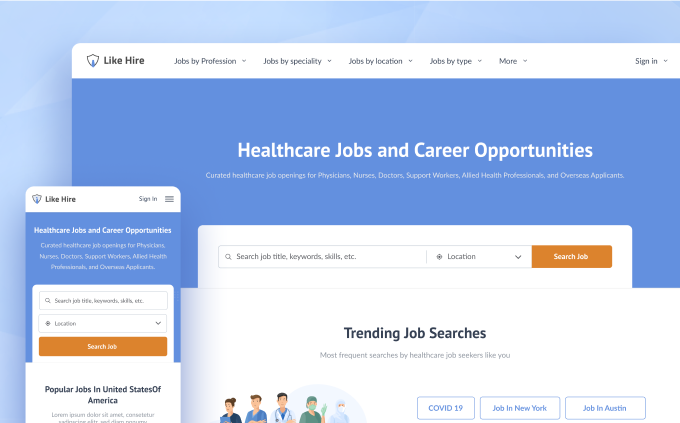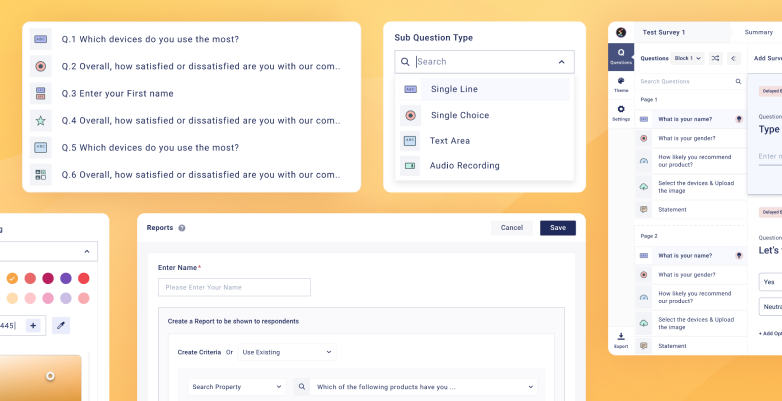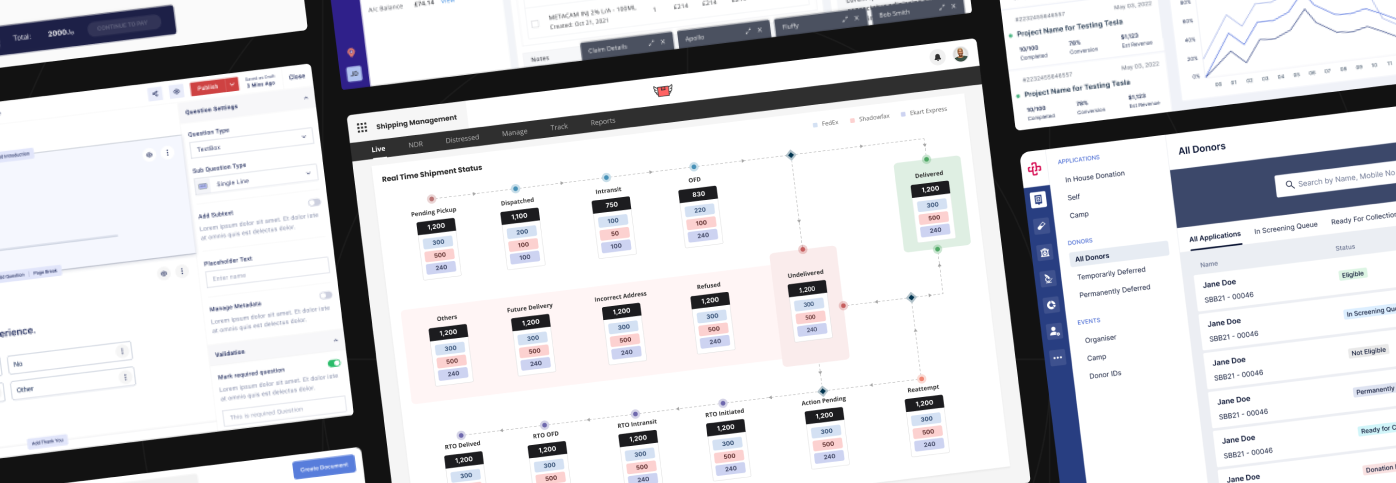Apr 16, 2024
How to evaluate a portfolio to hire UI UX designer?
Inspirations• Aakash Jethwani• 13 Mins reading time

Did you know that a carelessly designed website can drive away potential customers? According to Adobe, only 38% of website visitors interact with a website if the layout is attractive.
Hiring a UI/UX designer is a crucial decision that can significantly impact your website or app’s visual appeal and user experience. A UI UX designer’s portfolio indicates that the right designer can contribute to your business’s success.
To empower you to make an informed decision, we will provide guidelines on systematically assessing a UI UX designer portfolio. This way, you can confidently choose a designer who delivers the best results for your business.
Follow this process to hire UI UX designer who won’t make you regret it later.

Transform Your Digital Product With Our UI UX Design Services
Contact UsGuidelines to evaluate a UI UX designer’s portfolio
1. Look for originality:
When reviewing the designs, it is essential to ensure that they are truly original and unique. They should not simply be copies of popular trends but demonstrate a fresh perspective, creative approach, and mindset.
Evaluate elements such as the color palette, the use of patterns and textures, and the overall composition of the design. It is also helpful to consider the targeted audience segment and the context in which the design will be used.
Sushil Kumar’s portfolio in Behance showcases originality through its logo and branding designs for PixelKraft.
They integrated unconventional color schemes and abstract shapes to create a distinct visual identity, reflecting the client’s innovative nature. This original approach sets their designs apart and ensures a memorable brand presence.
2. Attention to detail:
Evaluate whether the designer has a keen eye for small design elements that have the potential to enrich the overall user experience.
Look for intuitive navigation, clear and concise messaging, easily identifiable buttons, and other visual cues that help users interact with the interface seamlessly and enjoyably.
In this portfolio of Manikuttan TK, attention to detail is evident in the micro-interactions incorporated within the Translator Buddy app interface. From subtle animation effects to the precise spacing between elements, every detail contributes to a smooth and intuitive user experience.
For instance, the subtle animation of the language selection dropdown enhances user engagement and simplifies navigation.
3. Storytelling:
A UI UX designer must be able to narrate an engaging and convincing story about their design process and the challenges they faced while solving the problem.
A designer’s ability to articulate their design journey not only helps them showcase their creativity and problem-solving skills but also helps the audience understand the reasoning behind the design decisions and the impact it can have on the end-users.
Example from Keepcom Portfolio: Sarah Doody’s portfolio effectively tells the story of Keepcom’s design process through immersive case studies. In this E-commerce Platform, they outline the user research conducted, the iterative design iterations, and the final implementation, accompanied by insightful commentary on design decisions.
Her storytelling approach humanizes the design process, making it relatable and compelling for potential clients.
4. Check for consistency:
Maintaining consistency in the designs regarding color, typography, layout, and other design elements is essential. The color palette should be well-defined and used consistently throughout the design.
Typography should also be consistent, including font style, size, and weight. The layout should be structured and consistent, with a clear information hierarchy. Maintaining consistency in the design elements will make the overall design more polished and professional.
Karolis Kosa’s portfolio exhibits a high consistency across Cujo, reflecting a strong commitment to brand identity and visual coherence. In his portfolio, each scheme maintains consistent typography, color schemes, and layout principles, reinforcing a unified brand image.
This consistency not only enhances brand recognition but also fosters a sense of trust and reliability among users.
5. Look for problem-solving skills:
Design is not just about making things look good; it’s about finding solutions to problems. Consider whether the designer has explained the issues it addresses when evaluating a design.
This means looking beyond the surface-level aesthetics and considering how the design functions in practice.
By understanding the problems a design intends to solve, you can better assess its effectiveness and determine whether it is the right solution for your needs.
As we saw earlier, Manikuttan TK’s portfolio showcases strong problem-solving skills through innovative design solutions.
In Translator Buddy, he implemented a streamlined onboarding process that simplified the user registration and language selection process, addressing the challenge of user drop-off during signup.
Additionally, he incorporated contextual help prompts and tooltips to guide users through complex translation tasks, enhancing usability and reducing user frustration.
These problem-solving interventions demonstrate a deep understanding of user needs and a commitment to delivering user-centric design solutions.
6. Consider the user’s perspective:
Carefully evaluate the designer’s approach to ensure the designs are genuinely user-centered. Specifically, look for signs that the designer has demonstrated empathy for the users and their needs throughout the design process.
Examine how the designer has approached user research, user testing, and feedback-gathering tasks.
A user-centered design approach considers the users’ needs, wants, and limitations and seeks to create intuitive, accessible, and user-friendly designs.
By prioritizing the user perspective in this way, you will be able to hire UI UX designer who can create products and services that genuinely meet the needs of their users, leading to greater satisfaction, engagement, and success.
Adithya Holehonnur’s portfolio showcases a user-centered approach through empathetic design solutions.
For instance, in Carl Zeiss India, he executed extensive user research and usability testing to know the unique challenges healthcare professionals face.
Based on user feedback, Aditya redesigned the app interface to prioritize essential features and minimize cognitive load, resulting in a more intuitive and efficient user experience.
This user-centered approach demonstrates a commitment to understanding user needs and delivering solutions that enhance user satisfaction.
7. Understand their process:
When looking to hire UI UX designer, evaluate their portfolio thoroughly to gain insight into their design process. A clear explanation of their design process in their portfolio will provide valuable information.
The design process should include several stages: research, creativity, design, and testing. A UI UX designer who includes detailed explanations of each stage demonstrates a thorough approach to design.
This kind of transparency can give you confidence that they will approach your project with the same level of upkeep and diligence.
Another example from Cujo’s portfolio is that he offers a comprehensive overview of their design process, from initial ideation to final implementation.
His portfolio is accompanied by detailed descriptions of research methodologies, design iterations, and user testing phases, providing transparency into their approach.
This systematic process ensures designs are grounded in user insights and iteratively refined for optimal results.
8. Understanding their design style
Understanding the design style is crucial in building a successful relationship with a designer.
It involves profoundly analyzing their previous work, communication style, and personal taste to gain insights into their design principles, aesthetics, and creative vision.
To understand a designer’s design style, review their portfolio and evaluate their previous projects’ design elements, such as typography, color schemes, layout, and imagery.
You can understand the designer’s design preferences, strengths, and weaknesses by examining the designer’s past work.
Adithya Holehonnur’s portfolio showcases a distinctive design style characterized by clean, minimalist aesthetics and intuitive user interfaces.
For instance, in his work for Sap Labs, India, he employed a minimalist design approach with ample white space and bold typography to create a modern and sophisticated brand identity.
Aditya’s consistent use of visual hierarchy and subtle animation effects enhanced usability and engagement, reflecting a design philosophy centered on simplicity and elegance.
9. Check for business results:
When evaluating designs, looking for concrete evidence that they have achieved their intended business goals is essential.
This evidence could be increased conversions, improved user engagement, or other measurable improvements that align with the company’s objectives.
By analyzing metrics and user feedback, you can gain valuable insights into a design’s effectiveness and make informed decisions about optimizing it further.
Ultimately, the goal is to hire UI UX designer to create good designs and drive tangible business results.
In the redesign work for “Cujo 3,” Karolis Kosas demonstrated a significant improvement in business results after implementing the new UI UX design.
Through a user-centric approach focused on enhancing usability and streamlining the user journey, Cujo experienced a 60% increase in user sign-ups within the first month of launching the redesigned platform.
Additionally, there was a noticeable decrease in customer support inquiries related to navigation and functionality issues, indicating improved user satisfaction and reduced friction in the user experience.
These tangible business results highlight the effectiveness of Karolis Kosas’s UI UX design in driving meaningful outcomes for the company.

Talk to Us for Expert UI UX Design Solutions
Contact UsThings to keep in mind while evaluating UI UX designer’s portfolio
1. The role requirements:
When hiring a designer, it is crucial to clearly understand the specific skills and experiences required for the job.
This understanding will enable you to evaluate whether the designer’s portfolio aligns with the job requirements and whether they possess the necessary qualifications to excel in the role.
By carefully assessing the candidate’s portfolio against the job requirements, you can ensure that you hire the best UI UX designer for the position and maximize your chances of success.
This guide will help you to check your UI UX designers skill before hiring them.
2. Company’s design language:
Acquaint yourself with your company’s design language. This will help you assess whether the designer’s approach is consistent with your company’s visual identity and brand image.
3. Current design trends:
Staying alongside the latest design trends can be valuable when evaluating a candidate’s work.
By keeping yourself up-to-date with the latest industry developments, you can better understand what is trending and famous in the design world.
It helps you assess whether or not a designer’s work aligns with current trends and gives you a sense of how well they keep up with industry developments. Furthermore, it can provide insight into a candidate’s ability to anticipate industry trends.
Read the latest UI UX trends right now to prepare yourself while hiring UI UX designer.
Common mistakes companies make when evaluating a UI UX portfolio
1. Focusing too much on aesthetics:
When evaluating a designer’s work, it’s essential to consider more than just the visual draw of their designs.
While aesthetics are undoubtedly crucial, they should not be the sole focus of your assessment. Examining the designer’s problem-solving skills and ability to create usable and functional designs is equally important.
2. Ignoring the design process:
To truly appreciate a designer’s work, understand their creative process. This understanding provides valuable insights into how they approach design challenges, collaborate with team members, and ultimately bring their ideas to life.
By delving into a designer’s process, you can gain a deeper appreciation for research of design and better understand the unique skills and talents that go into creating beautiful and functional designs.
3. Ignoring the user’s perspective:
When creating designs, it is essential to keep the users at the forefront of the process. This means considering their needs, preferences, and behaviors to ensure the final product is user-centered.
If this is not the case, it can be a red flag that the design may need to meet the users’ expectations and requirements, leading to a suboptimal user experience.
4. Not considering business results:
Design is crucial in achieving business goals and objectives. The primary purpose of a design portfolio is to showcase a designer’s ability to create solutions that deliver tangible business results.
A UI UX designer’s portfolio must demonstrate this fundamental design aspect to avoid raising concerns among potential clients or employers.
5. Judging solely based on the number of projects:
When it comes to design execution, it is essential to prioritize quality over quantity. Instead of focusing on completing numerous projects, it is more valuable to concentrate on executing a few projects exceptionally well.
Well-executed projects yield better results and have a more significant impact on many mediocre projects.
6. Missing the designer’s role in team projects:
It’s crucial to clearly understand the designer’s contributions to the projects presented in their portfolio. This information will help you evaluate the candidate’s skills, work style, and ability to collaborate effectively with others.
Review the portfolio thoroughly and ask the designer specific questions about their role and responsibilities in each project.
7. Neglecting the designer’s ability to adapt to different styles:
In design, versatility and adaptability to different design languages are concepts. A skilled UI UX designer should be able to modify their design approach and create designs that align with diverse design languages.
This allows them to cater to varying design requirements and produce practical and visually appealing designs.
Read further about the top 10 skills to check before you hire UI UX designer for your business.
8. Ignoring the use of design principles:
A competent designer should possess a deep understanding of the fundamental principles of design and be able to apply them skillfully in their work.
These principles include, but are not limited to, balance, contrast, color, typography, space, and proportion.
The designer’s proficiency in utilizing these principles should be evident in their creative outputs, which should be aesthetically pleasing, functional, and effective in communicating the intended message to the targeted audience.
Final thought: Don’t forget to evaluate this!
Don’t forget to take the portfolio’s user experience itself into account.
- Is it a fun and easy user experience to examine their portfolio?
- Was it written in plain language or industry jargon?
- Did it make sense, and how did the flow work? Was there confusion or information in the portfolio presentation?
Ultimately, UI UX designers should tailor their portfolio for individuals like you.

Get Ahead of Your Competition With Our UI UX Design Services
Hire UsFrequently asked questions:
What should be in a UI UX designer portfolio?
A UI UX designer portfolio should showcase various skills and experiences relevant to user interface (UI) and user experience (UX) design. Key elements to include are:
- Case studies:
Detailed explanations of your design process, including problem identification, research, ideation, prototyping, testing, and final implementation.
- Visual designs:
Examples of your visual design skills include wireframes, mockups, and high-fidelity prototypes.
- Usability testing results:
Demonstrate how your designs have been validated through usability testing and iterations.
What is involved in the evaluation of a design portfolio?
The evaluation of a UI UX designer portfolio typically involves assessing several key factors:
- Design skills:
The quality of visual design, attention to detail, and ability to create aesthetically pleasing interfaces.
- Problem-solving ability:
The effectiveness of the designer’s solutions to user needs and design challenges.
- User-centered design approach:
The extent to which the designer considers user research, usability principles, and empathy for the end-user throughout the design process.
- Process documentation:
The clarity and depth of the designers’ case studies demonstrate their ability to articulate their design process and decision-making.
Why understanding the design process is important?
Understanding the design process is crucial to hire UI UX designer because it provides a structured framework for solving design problems effectively.
By following a systematic process that involves user research, ideation, prototyping, testing, and iteration, designers can create solutions that meet user needs and achieve business goals.
Understanding the design process helps designers communicate their approach and rationale to stakeholders, collaborate effectively with team members, and adapt to changing project requirements.
What questions to ask in a UI UX portfolio review?
- Can you walk us through the design process for this project?
- How did you approach user research and incorporate user feedback into your designs?
- What were your biggest challenges during this project, and how did you overcome them?
- Can you explain the rationale behind specific design decisions you made?
- How do you prioritize usability and aesthetics in your designs?
- Can you discuss a project where you had to pivot your design direction based on user feedback or project constraints?
- What tools and methodologies do you use in your design process?
- Do you have experience working with specific types of users or industries, and how does that influence your design approach?
Subscribe to
blogs
Related Blogs
Benefits of UI UX design: How it transforms user experience
Reading Time: 9 minutes In the dynamic world of digital interactions, UI/UX design stands as the backbone of creating meaningful and seamless experiences for users. Whether you’re a seasoned designer or just stepping into the realm of UI/UX, understanding the advantages of UI/UX Design and benefits of user experience design can significantly impact your approach to crafting interfaces that […]
Dec 28, 2023 • By Aakash Jethwani

Essential UI UX design tips for outstanding UX experiences
Reading Time: 9 minutes In the rapidly changing digital landscape, UI/UX Design holds unparalleled importance. Its significance lies in crafting experiences that resonate with users, ensuring their satisfaction and loyalty. A meticulously designed UI/UX becomes a secret weapon in the competitive tech space, setting a product apart from the crowd. Beyond aesthetics, it plays a pivotal role in increasing […]
Dec 27, 2023 • By Aakash Jethwani




